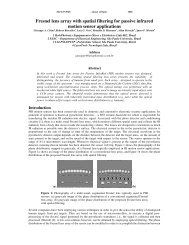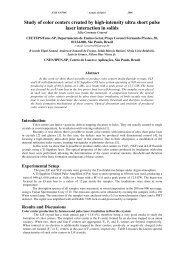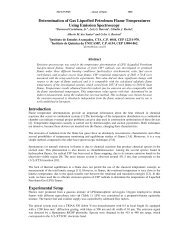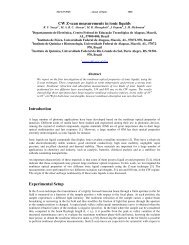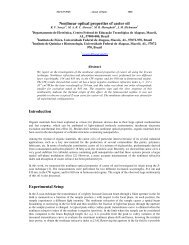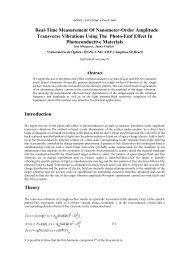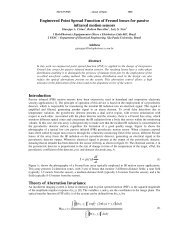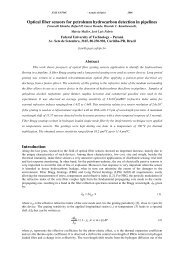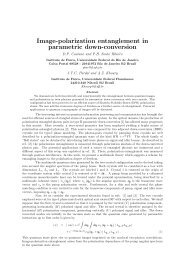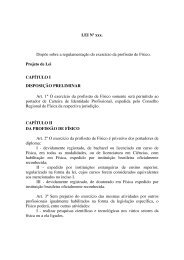Temporal evolution of coherence resonances in degenerate two ...
Temporal evolution of coherence resonances in degenerate two ...
Temporal evolution of coherence resonances in degenerate two ...
You also want an ePaper? Increase the reach of your titles
YUMPU automatically turns print PDFs into web optimized ePapers that Google loves.
XXVI ENFMC - Annals <strong>of</strong> Optics Volume5 - 2003<br />
<strong>Temporal</strong> <strong>evolution</strong> <strong>of</strong> <strong>coherence</strong> <strong>resonances</strong> <strong>in</strong> <strong>degenerate</strong> <strong>two</strong><br />
level atoms<br />
P. Valente, H. Failache and A. Lezama<br />
Instituto de Física, Facultad de Ingeniería, C. de correo 30, C.P. 11000, Montevideo, Uruguay<br />
pvalente@f<strong>in</strong>g.ed.uy, heraclio@f<strong>in</strong>g.edu.uy, alezama@f<strong>in</strong>g.edu.uy<br />
Abstract<br />
We study the temporal <strong>evolution</strong> <strong>of</strong> <strong>coherence</strong> <strong>resonances</strong> <strong>of</strong> Electromagnetically Induced<br />
Transparency (EIT) and Electromagnetically Induced Absorption (EIA) <strong>in</strong> pump-probe<br />
spectroscopy <strong>of</strong> <strong>degenerate</strong> <strong>two</strong> level atoms. Two complementary theoretical approaches were<br />
used: simplified models, lead<strong>in</strong>g to analytical expressions for the time dependence <strong>of</strong> the transient<br />
probe absorption and a realistic numerical calculation where the Zeeman degeneracy is fully<br />
accounted for. Both treatments are <strong>in</strong> qualitative agreement with the transient probe absorption<br />
for the 85 Rb D 2 l<strong>in</strong>e <strong>in</strong> an atomic beam experiment.<br />
Introduction<br />
The <strong>in</strong>teraction <strong>of</strong> an atomic system with mutually coherent optical waves can lead to quantum coherent effects.<br />
One particular example <strong>of</strong> such effects is Electromagnetically Induced Transparency (EIT), where the absorption<br />
<strong>of</strong> a probe field can be reduced, even elim<strong>in</strong>ated, by the action <strong>of</strong> a pump<strong>in</strong>g field[1]. When the <strong>two</strong> fields<br />
satisfies a <strong>two</strong>-photon (Raman) resonance condition a coherent superposition <strong>of</strong> the atomic states that do not<br />
<strong>in</strong>teract with light is created. Such superposition is called a dark state, and Coherent Population Trapp<strong>in</strong>g (CPT)<br />
takes place[2]. The stationary and transient properties <strong>of</strong> EIT have been explored by many authors <strong>in</strong> simple<br />
(i)<br />
b<br />
(ii)<br />
b<br />
d<br />
ω 1<br />
ω 2<br />
ω 1<br />
ω 2<br />
ω 1<br />
a c a c<br />
Figure 1: Model systems for EIT (i) and EIA (ii) <strong>coherence</strong> <strong>resonances</strong>. ω 1 and ω 2 are the pump and probe<br />
frequencies, respectively. Dashed l<strong>in</strong>es <strong>in</strong>dicate spontaneous emission decay channels.<br />
model systems. It was demonstrated that the characteristic time for EIT is proportional to the square <strong>of</strong> the<br />
pump<strong>in</strong>g field Rabi frequency Ω 1 divided by the excited state relaxation time Γ[3].<br />
Another k<strong>in</strong>d <strong>of</strong> <strong>coherence</strong> resonance corresponds Electromagnetically Induced Absorption (EIA). Here, the<br />
absorption <strong>of</strong> a probe field is <strong>in</strong>creased <strong>in</strong> presence <strong>of</strong> a coupl<strong>in</strong>g wave[4]. Although similar to EIT <strong>in</strong> many<br />
features, except for the sign, EIA cannot be associated with any coherent superposition <strong>of</strong> states. EIA was first<br />
observed <strong>in</strong> <strong>degenerate</strong> <strong>two</strong> level system (DTLS) illum<strong>in</strong>ated by a resonant pump and the probe was scanned<br />
around the same transition. When the <strong>two</strong> fields satisfies a <strong>two</strong>-photon (Raman) resonance condition there is an<br />
<strong>in</strong>crease <strong>of</strong> absorption. It was established that EIA is a consequence <strong>of</strong> the transfer <strong>of</strong> <strong>coherence</strong> generated from<br />
the excited to the lower state by spontaneous emission[5].. In this work we present the first study <strong>of</strong> the temporal<br />
<strong>evolution</strong> <strong>of</strong> the EIA resonance and put <strong>in</strong> evidence similarities and differences with EIT.<br />
Simple Models<br />
A three level Λ system is the simplest model for EIT. The level scheme is shown <strong>in</strong> Figure 1(i). A pump field<br />
couples the levels a and b and a low <strong>in</strong>tensity probe connect the b and c levels. Follow<strong>in</strong>g a perturbative analysis<br />
to first order <strong>in</strong> the probe, the Optical Bloch Equations (OBE) can be <strong>in</strong>tegrated <strong>in</strong> time giv<strong>in</strong>g the no l<strong>in</strong>ear<br />
probe absorption:
XXVI ENFMC - Annals <strong>of</strong> Optics Volume5 - 2003<br />
Figure 2: Plot <strong>of</strong> the function F(x,y,τ) evaluated for x=0.02. (a) τ dependence for fixed y. (b) y dependence for fixed τ.<br />
∆α<br />
Λ<br />
( t)<br />
= −KF(<br />
β / Γ,<br />
δ / Γ,<br />
Γτ<br />
)<br />
⎡<br />
⎢<br />
1−<br />
exp<br />
F(<br />
x,<br />
y,<br />
τ ) = Re⎢<br />
⎢ ⎛ 1 ⎞<br />
⎢ ⎜ − iy ⎟<br />
⎣ ⎝ 2 ⎠<br />
( − ( x − iy)<br />
τ )<br />
⎤<br />
( )<br />
⎥ ⎥⎥ x − iy ⎥<br />
⎦<br />
where K is a constant that depends on the <strong>in</strong>tensity <strong>of</strong> both fields, δ is the detun<strong>in</strong>g between the <strong>two</strong> fields and<br />
2Ω<br />
β =<br />
Γ<br />
def<strong>in</strong>es the characteristic time <strong>of</strong> the resonance. This function presents the most important features <strong>of</strong> EIT<br />
transient behavior. For long times F ( x,<br />
y,<br />
∞)<br />
is a Lorentzian function <strong>of</strong> y with width 2x. For short times, it<br />
presents a central peak <strong>of</strong> width ~ 4π / τ and oscillat<strong>in</strong>g w<strong>in</strong>gs <strong>of</strong> period ~ 2π / τ . For fixed x and y the<br />
absorption is a damped oscillation with frequency y/2π and damp<strong>in</strong>g rate β. A plot <strong>of</strong> F is shown <strong>in</strong> Figure 2.<br />
The simplest model for EIA is a N four level system, as seen <strong>in</strong> Figure 1 (ii). The pump field couples the a-b and<br />
c-d transitions, while the probe couples the c-b one, and the three transitions have relative dipole matrix elements<br />
A, B and 1. To the first order <strong>in</strong> the probe, the absorption is given by<br />
∆α<br />
N<br />
( t)<br />
Ω<br />
β ' = 2<br />
Γ<br />
= −<br />
⎛ Γ<br />
2<br />
1<br />
⎜<br />
⎝<br />
K'<br />
2<br />
⎞<br />
⎟<br />
2 ⎠<br />
2<br />
( 1−<br />
A )<br />
+ δ<br />
2<br />
2<br />
1<br />
A<br />
+ K'<br />
Γ<br />
2<br />
2<br />
F(<br />
β '/<br />
Γ,<br />
δ / Γ,<br />
Γτ<br />
)<br />
The first term presents the effect <strong>of</strong> saturation <strong>of</strong> the c-d transition caused by the pump and the second term<br />
shows the EIA resonance. We note that the spectral and temporal behavior is similar to the EIT case, except for<br />
2<br />
the sign <strong>in</strong>version and the narrow<strong>in</strong>g factor ( 1 A )<br />
consequence EIA will be slower than EIT <strong>in</strong> its <strong>evolution</strong>.<br />
− for the damp<strong>in</strong>g rate and stationary spectral width. As a<br />
Realistic Models<br />
We consider <strong>two</strong> <strong>degenerate</strong> levels <strong>of</strong> angular momentum F g and F e <strong>in</strong> <strong>in</strong>teraction with <strong>two</strong> fields. The optical<br />
Bloch equations (OBE) are given by<br />
∂ρ<br />
− i Γ<br />
q q<br />
= [ H , ρ] − { Pe<br />
, ρ} + Γ ∑Qge<br />
ρQeg<br />
∂t<br />
!<br />
2<br />
q=−1,0,1
XXVI ENFMC - Annals <strong>of</strong> Optics Volume5 - 2003<br />
Figure 3: Calculated temporal and spectral dependence <strong>of</strong> the no l<strong>in</strong>ear probe absorption for <strong>two</strong> closed transitions.<br />
(a) F g =1→ F e =0, the vertical axes <strong>in</strong>dicates transparency. (b) F g =2→ F e =3 transition, the vertical axes <strong>in</strong>dicates<br />
absorption.<br />
where H is the total Hamiltonian,<br />
Q<br />
2 F + 1<br />
q<br />
e<br />
q<br />
= and P<br />
ge<br />
ge e is the projector on the excited state. It can<br />
F<br />
g<br />
D F<br />
e<br />
be seen that the condition to the occurrence <strong>of</strong> EIA is 0 < F g < F e . The OBE are first solved with no probe field<br />
to all orders after what the coupl<strong>in</strong>g with the probe is <strong>in</strong>cluded as a perturbation. The results is shown <strong>in</strong> Figure<br />
3. For a given <strong>in</strong>teraction time the EIT is very close to its stationary state, but the EIA curve still present strong<br />
oscillations. The ma<strong>in</strong> features <strong>of</strong> the simple model calculation are reproduced by the numerical results. Once<br />
aga<strong>in</strong>, the EIA <strong>evolution</strong> is slower and the correspond<strong>in</strong>g <strong>resonances</strong> narrower.<br />
Experiment<br />
We have studied the temporal <strong>evolution</strong> <strong>of</strong> the probe absorption for the <strong>two</strong> closed transitions <strong>of</strong> the D 2 l<strong>in</strong>e <strong>of</strong><br />
Laser<br />
AOM1<br />
Chopper<br />
AOM2<br />
D<br />
PBS<br />
Fiber<br />
Lock-<strong>in</strong><br />
z<br />
Slit<br />
Atomic beam<br />
PD<br />
Telescope<br />
PBS<br />
Figure 4: Experimental setup for the atomic beam experiment. PBS: polariz<strong>in</strong>g beam splitter. AOM: acoustooptical<br />
modulator. PD: photodiode.<br />
85 Rb, namely 5S 1/2 (F=2)→ 5S 3/2 (F’=1) that presents EIT and 5S 1/2 (F=3)→ 5S 3/2 (F’=4) that presents EIA. The<br />
experiment was done <strong>in</strong> a rubidium atomic beam. A mov<strong>in</strong>g slit after the <strong>in</strong>teraction zone select atoms with<br />
different <strong>in</strong>teraction times. The pump and probe fields hav<strong>in</strong>g l<strong>in</strong>ear and orthogonal polarizations are obta<strong>in</strong>ed
XXVI ENFMC - Annals <strong>of</strong> Optics Volume5 - 2003<br />
from the same diode laser us<strong>in</strong>g <strong>two</strong> acousto-optic modulators (AOM). The probe frequency is scanned by a<br />
tunable rf source that controls one <strong>of</strong> the AOMs. In order to detect only the no l<strong>in</strong>ear contribution <strong>of</strong> the signal, a<br />
<strong>two</strong>-frequency modulation was used. The pump and probe are mechanically modulated with frequencies f 1 and f 2<br />
while a lock-<strong>in</strong> amplifier analyze the sum frequency (f 1 + f 2 ).<br />
The results are shown <strong>in</strong> Figure 5, where we see the <strong>evolution</strong> <strong>in</strong> time <strong>of</strong> the EIT and EIA <strong>resonances</strong>. A good<br />
qualitative agreement is observed between the theoretical predictions and the experimental observations. The<br />
EIT resonance rapidly reaches its stationary state while the EIA <strong>resonances</strong> exhibit a much slower behavior.<br />
Dur<strong>in</strong>g the whole measurement time <strong>in</strong>terval the EIA presents a cont<strong>in</strong>uous narrow<strong>in</strong>g while the l<strong>in</strong>e spectra is<br />
clearly not Lorentzian.<br />
Conclusions<br />
We have presented the temporal <strong>evolution</strong> <strong>of</strong> the EIA <strong>coherence</strong> resonance and compared with that <strong>of</strong> EIT. The<br />
results provided by the analysis <strong>of</strong> the simple models and the numeric calculations are <strong>in</strong> good agreement with an<br />
experiment done <strong>in</strong> an atomic beam. We have seen that the EIT resonance reaches its stationary state <strong>in</strong> a shorter<br />
time than EIA. Because the existence <strong>of</strong> a dark state its characteristic time is just an optical pump time. In the<br />
Figure 5:Experimental no l<strong>in</strong>ear probe absorption spectra at different positions <strong>of</strong> the movable slit. (a) 5S 1/2 (F=3)→<br />
5S 1/2 (F=4) transition, the vertical axes <strong>in</strong>dicates absorption. (b) 5S 1/2 (F=2)→ 5S 1/2 (F=1) transition, the vertical axes<br />
<strong>in</strong>dicates transparency.<br />
EIA case, a narrow<strong>in</strong>g factor appear<strong>in</strong>g <strong>in</strong> the probe absorption transient equation makes its <strong>evolution</strong> shorter and<br />
the stationary spectra narrower.<br />
Acknowledgments<br />
The authors thank the PEDECIBA and CSIC, Uruguayan agencies.<br />
References<br />
[1] S. E. Harris, Phys. Today 50(7), 36 (1997) and references there <strong>in</strong>.<br />
[2] E. Arimondo, <strong>in</strong> Coherent Population trapp<strong>in</strong>g, special issue <strong>of</strong> Prog. Opt. 35, 257 (1996)<br />
[3] B.D. Agap’ev, M.D. Gornyï and B.G. Matisov, Usp. Fiz. Nauk 163, 1 (1993); Yong-q<strong>in</strong>g Li and M<strong>in</strong> Xiao,<br />
Opt. Lett 20, 1489 (1995); E. A. Korsusnky, W. Maichen an L. W<strong>in</strong>dholz, Phys. Rev. A 56, 3908 (1997).<br />
[4] A. M. Akulsh<strong>in</strong>, S. Barreiro and A. Lezama, Phys. Rev. A 57, 2996 (1998); A. Lezama, S. Barreiro and A.<br />
M. Akulsh<strong>in</strong> Phys. Rev. A 59, 4732 (1999); A. Lezama, S. Barreiro, A. Lipsich and A. M. Akulsh<strong>in</strong> Phys.<br />
Rev. A 61, 013801 (2000).<br />
[5] A. V. Taichenachev, A. M. Tumaik<strong>in</strong> and V. I. Yud<strong>in</strong>, Phys. Rev. A 61, 011802 (2000).



